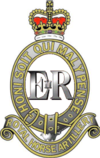Royal Horse Artillery
| Royal Horse Artillery | |
|---|---|

Cypher of the Royal Horse Artillery
|
|
| Active | 1 February 1793 – present |
| Allegiance |
|
| Branch |
|
| Type | Horse Artillery |
| Role |
The King's Troop - Ceremonial 1st Regiment - Field Artillery 3rd Regiment - Field Artillery 7th Regiment - Airborne Artillery |
| Size | Three Regiments and one Ceremonial Battery plus affiliated TA Units |
| Part of | Royal Artillery |
| Garrison/HQ | The King's Troop - London 1st Regiment - Tidworth 3rd Regiment - Newcastle Upon Tyne 7th Regiment - Colchester |
| March | Bonnie Dundee (Gallop march); The Keel Row (Trot March); The Royal Artillery Slow March sometimes referred to as Duchess of Kent March (walk march) |
| Commanders | |
| Captain General, Royal Artillery | HM The Queen |
| Colonel Commandant | General Sir Alexander Harley, KBE, CB |
| Insignia | |
| Tactical Recognition Flash |  |
The regiments of the Royal Horse Artillery (RHA), dating from 1793, are part of the Royal Regiment of Artillery (commonly termed Royal Artillery) of the British Army. Horses are still in service for ceremonial purposes but were phased out from operational deployment during the 1930s.
Almost all the batteries of the Royal Horse Artillery have served continuously since the French Revolutionary Wars or Napoleonic Wars, except the King's Troop which has existed since 1946 and M Battery which was 'reanimated' in 1993.
In 1793, in the course of the French Revolutionary Wars, Great Britain and allied European powers declared war on France over French occupation of the Rhine delta and Antwerp, precipitating the Flanders Campaign. Britain remained in conflict with France for almost 22 years, during which time significant progress was achieved in artillery development. The first two troops of Horse Artillery (A –later entitled "The Chestnut Troop"– and B) were raised in January 1793 at Goodwood, East Sussex, by the Master-General of the Ordnance, the 3rd Duke of Richmond, to provide fire support for the cavalry. They were joined by two more troops in November 1793. Each troop had six 6-pounder guns. All RHA personnel were mounted. Included in the establishment were 45 drivers and 187 horses, making it the first self-contained fighting unit of artillery.
Initially, horses were hired with civilian drivers. In 1794 a Driver Corps was raised which, however, did not formally become a unit of the Royal Artillery until after Waterloo. There were many disadvantages of the divided control until horses and drivers were organised into the RHA troops. Another development was the formation of a headquarters staff providing a channel between the regiment and the Board of Ordnance. Captain John Macleod was the first brigade major and became the first deputy-adjutant-general in 1795. By 1806, eleven troops had been formed, with ten companies of the Royal Irish Artillery incorporated, as the Seventh Battalion, after the union with Ireland in 1801.
...
Wikipedia
